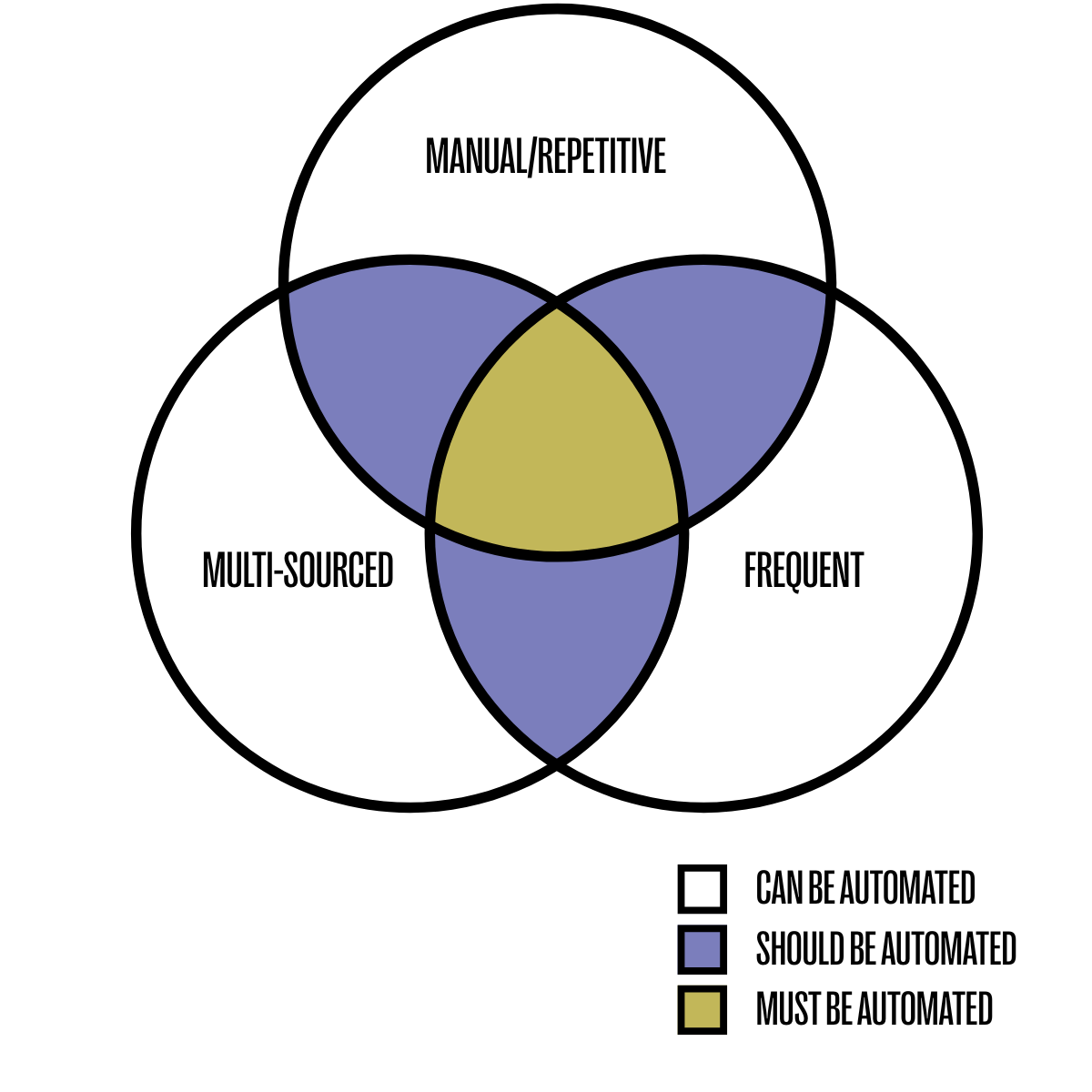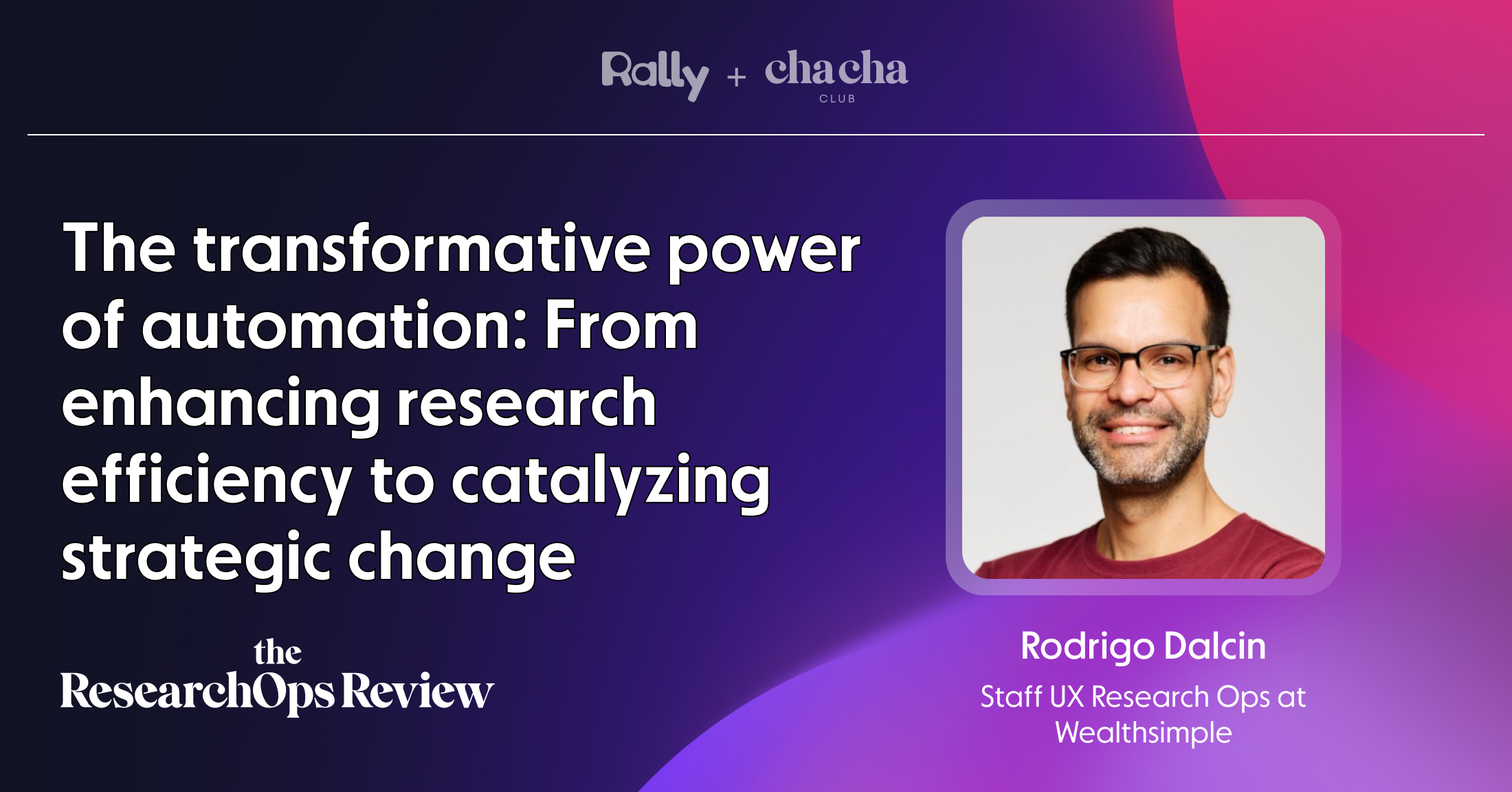The transformative power of automation: From enhancing research efficiency to catalyzing strategic change
In the ever-evolving field of Research Operations, automation can be a real game-changer. Long before AI became the technology du jour, automations have been leveraged in the Research Ops world to streamline processes, increase efficiency, and boost organizational awareness of past, present, and future research initiatives.
It can be tempting to use an automation tool to take care of everything that feels burdensome and repetitive — I’ve certainly succumbed to this temptation. Struggling to follow up with people who do research (PWDRs)1 on the status of their research projects, I’ve employed a Slack automation only to realize that Slack bots are just as easily ignored as me! (More on that later).
As the saying goes, “When all you have is a hammer, everything can look like a nail!” But automations aren’t a panacea: they take time to build, need maintenance to continuously operate well, and lack the warmth of human interaction. But by learning how to identify the right problems to solve through automation, not only can you save time and money, you can also help research deliver more business impact as a result.
Automate the right things
The day-to-day chunks of back-and-forth, mindless administrative research tasks can sometimes lead to tunnel vision. And I speak from experience here: it took me accidentally sending out a recruitment email to a batch of research participants using “To:” instead of “Bcc:” (and causing a minor data breach as a result) to realize I could use Gmail’s mail merge feature to build a spreadsheet-based mailing list and avoid the mindless copying and pasting altogether. This taught me to always prioritize automation for tedious, repetitive tasks that take a lot of time but don’t require a lot of focus, which can lead to mistakes — not to mention wasted time and talent.
In an age of what seems like a perpetual UX Research reckoning, automating these tasks can not only significantly reduce the time and effort (and money) required to kick off a research project, but also free up the bandwidth of UX researchers, managers, and other valuable team members for strategic and influential work that generates measurable business value — a crucial point at all times, but especially in the current economic climate.
There are loads of things that, if automated, could improve a research process: recruiting a large pool of research participants, running internal surveys, following up with PWDRs on the status of their ongoing research projects, collecting contextual information in preparation for a research project kickoff, or importing raw, unstructured customer input into a research repository for further feedback analysis. But before you try to automate all of these, consider the following questions:
- Does the process you’re trying to automate involve a significant number of manual, repetitive tasks or steps that take up time that could be dedicated to high-level, strategic work?
- Is it part of a recurring ritual or cadence, usually taking place after specific activities, or on the same day of the week, month, or quarter?
- Does it require connecting or updating information across different sources, forming a base or starting point for more complex work?
If the answer to any of these questions was yes, then you likely have a good research automation candidate on your hands (see Figure 1). Otherwise, you’re probably looking at inefficiencies rooted in a different issue, such as too much organizational red tape or lack of adequate tooling…which might still be a great problem to solve, but may require a heavier lift than implementing a simple automation. Besides, automations aren’t just about machinery; they’re also always about people.

Consider the human factor
While leading research operations for an identity management SaaS company, I replaced post-research debrief calls (short meetings with everyone involved to review how the research study went, how the insights were used to inform product and business decisions, and to identify gaps and opportunities for improvement in the research process) with automated Slack surveys, thinking I’d save hours of work each month. Needless to say, the response rate plummeted. It wasn’t until a product team member told me that those debrief calls made them feel like their input really mattered, that I realized what the issue was. I’d optimized for efficiency but had forgotten that sometimes the human connection behind “meetings that could’ve been emails” (or Slack surveys) is precisely what made the process work. So, before you move forward with any automation work, consider the following question: Does this task involve human interaction that, if eliminated, would negatively impact the level of engagement required for the task to be effective?
While automation can bring numerous benefits, it can’t replace human interaction where it matters most. The most successful automation strategies in Research Ops will be those that strike a balance between efficiency and personal engagement, leveraging technology to support and amplify human expertise rather than trying to replace it. The same can be said for emerging technologies like AI.
Work with what you have
Now that you’ve identified the perfect automation candidate, the next essential step is to think about how to automate it with the tools at hand. Automation platforms like Workato or Zapier can help you integrate with existing platforms in your company’s tech ecosystem, but even if you don’t have access to these automation tools, you can still build automation into your workflows. For instance, you can use:
- Built-in automations. Commonly used tools like Jira and Slack come with customizable workflows that can be used to automate tasks. This is particularly useful if they’re already largely adopted within the organization, requiring less friction and change management for users.
- Scheduling. Using your company’s scheduling tool of choice to automate booking of research sessions with research participants and observers, or to set up recurring reminders for tasks like following up with research participants or submitting research reports to the library.
- Templating. Any knowledge base or workspace suite like Confluence, Notion, or Google Workspace can give you the ability to create templates for research plans, interview guides, outreach emails, and reports, all while making them easily accessible to your team.
- Knowledge management. AI platforms like Google’s NotebookLM and Glean can significantly reduce the toil involved in compiling different sources of knowledge into simplified documentation, such as a research methodology playbook. You can use them to reference slide decks created for internal training or workshops, as well as video recordings. Just remember to give credit where it’s due when referencing external sources.
- Sharing research findings. Many companies struggle with ensuring that customer insights reach the right people at the right time. Automated processes can help by:
- Standardizing the format of research summaries and reports
- Distributing findings to relevant decision-makers in your organization based on predefined rules (e.g., by themes, teams, customer segment or revenue)
- Showcasing key research metrics and findings over time (e.g., using dashboards or reports)
- Coding. Google Apps Script in Google Workspace can be used to automatically populate a research tracker spreadsheet when a new study is initiated, generate and send personalized email invitations to study participants, or create a new project folder structure when a research request is approved. Learning programming languages with simple and readable syntax like Python can also be useful to create scripts and automate repetitive tasks like file organization or data cleaning, such as preparing raw survey data for analysis (I highly suggest starting with Al Sweigart’s Automate the Boring Stuff with Python, available for free here).
While each of these automations requires various degrees of commitment and expertise, they also present excellent opportunities for skill development, especially when it comes to mastering new tools and use cases.
Harness automation as strategy
Beyond the most obvious use case of reducing the burden of endless tactical work, research automation can become a powerful currency to obtain buy-in from tough stakeholders, establish cross-functional partnerships, and help boost the importance of user research in your organization — work that can elevate Research Ops from a purely tactical role to a more strategic practice.
In one of my previous jobs, I used automation as a ‘partnership currency’ to enrich our research insights repository with feedback from various sources of customer feedback across the company. By proposing an initiative to gather all existing feedback data into a single, centralized place using integrations, I quickly obtained buy-in from multiple stakeholders willing to partner to unsilo customer insights, making them easily accessible to a greater number of teams or domains.
By effectively harnessing both the tactical and strategic potentials of automation while maintaining the core principles of human-driven support, Research Ops professionals can elevate their role while freeing up time and resources to align research practices with business goals. This work can ultimately enhance the value and impact of user research within product organizations, which should be the fundamental mission of Research Ops.
Start small and iterate
As you embark on your own journey to automate aspects of your company’s research process, remember to start small and iterate. Ask yourself the right questions, choose one or two good sets of tasks to automate initially, learn from the experience, and then gradually expand your automation efforts. This will allow you to build confidence in your approach and give your team time to adapt to any changes resulting from it.
And the journey is ongoing. As new tools and technologies emerge, there will be more opportunities to refine and improve how research is done — and how repetitive tasks are automated. The key is to remain adaptable and always question how to work smarter (not just harder) to support and elevate the research practice in your organization.
Edited by Kate Towsey and Katel LeDu.
👉 The ResearchOps Review is the publication arm of the Cha Cha Club – a members' club for Research Ops professionals. Subscribe for smart thinking and sharp writing, all laser-focused on Research Ops.
1 PWDR (pau·duh) is an acronym that was invented in 2019 by Kate Towsey, the editor in chief of The ResearchOps Review and the author of Research That Scales: The Research Operations Handbook (Rosenfeld, 2024).
Rally’s Research Ops Platform enables you to do better research in less time. Find out how you can use Rally to empower your teams to talk to their users, without disjointed tooling and spreadsheets. Explore Rally now by setting up a demo.

